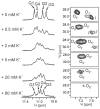Insight into Tetramolecular DNA G-Quadruplexes Associated with ALS and FTLD: Cation Interactions and Formation of Higher-Ordered Structure
- PMID: 37686239
- PMCID: PMC10487854
- DOI: 10.3390/ijms241713437
Insight into Tetramolecular DNA G-Quadruplexes Associated with ALS and FTLD: Cation Interactions and Formation of Higher-Ordered Structure
Abstract
The G4C2 hexanucleotide repeat expansion in the c9orf72 gene is a major genetic cause of familial amyotrophic lateral sclerosis (ALS) and frontotemporal lobar degeneration (FTLD), with the formation of G-quadruplexes directly linked to the development of these diseases. Cations play a crucial role in the formation and structure of G-quadruplexes. In this study, we investigated the impact of biologically relevant potassium ions on G-quadruplex structures and utilized 15N-labeled ammonium cations as a substitute for K+ ions to gain further insights into cation binding and exchange dynamics. Through nuclear magnetic resonance spectroscopy and molecular dynamics simulations, we demonstrate that the single d(G4C2) repeat, in the presence of 15NH4+ ions, adopts a tetramolecular G-quadruplex with an all-syn quartet at the 5'-end. The movement of 15NH4+ ions through the central channel of the G-quadruplex, as well as to the bulk solution, is governed by the vacant cation binding site, in addition to the all-syn quartet at the 5'-end. Furthermore, the addition of K+ ions to G-quadruplexes folded in the presence of 15NH4+ ions induces stacking of G-quadruplexes via their 5'-end G-quartets, leading to the formation of stable higher-ordered species.
Keywords: ALS; DNA; FTLD; NMR; c9orf7; cations; quadruplex.
Conflict of interest statement
The authors declare no conflict of interest.
Figures







Similar articles
-
Characterization of DNA G-quadruplex species forming from C9ORF72 G4C2-expanded repeats associated with amyotrophic lateral sclerosis and frontotemporal lobar degeneration.Neurobiol Aging. 2015 Feb;36(2):1091-6. doi: 10.1016/j.neurobiolaging.2014.09.012. Epub 2014 Sep 28. Neurobiol Aging. 2015. PMID: 25442110
-
Solution structure of a DNA quadruplex containing ALS and FTD related GGGGCC repeat stabilized by 8-bromodeoxyguanosine substitution.Nucleic Acids Res. 2015 Sep 30;43(17):8590-600. doi: 10.1093/nar/gkv815. Epub 2015 Aug 7. Nucleic Acids Res. 2015. PMID: 26253741 Free PMC article.
-
Topology of a G-quadruplex DNA formed by C9orf72 hexanucleotide repeats associated with ALS and FTD.Sci Rep. 2015 Nov 13;5:16673. doi: 10.1038/srep16673. Sci Rep. 2015. PMID: 26564809 Free PMC article.
-
Structural insight into C9orf72 hexanucleotide repeat expansions: Towards new therapeutic targets in FTD-ALS.Neurochem Int. 2016 Nov;100:11-20. doi: 10.1016/j.neuint.2016.08.008. Epub 2016 Aug 15. Neurochem Int. 2016. PMID: 27539655 Review.
-
Unconventional features of C9ORF72 expanded repeat in amyotrophic lateral sclerosis and frontotemporal lobar degeneration.Neurobiol Aging. 2014 Oct;35(10):2421.e1-2421.e12. doi: 10.1016/j.neurobiolaging.2014.04.015. Epub 2014 Apr 19. Neurobiol Aging. 2014. PMID: 24836899 Review.
Cited by
-
Frontotemporal lobar degeneration and amyotrophic lateral sclerosis: A bibliometric analysis.Medicine (Baltimore). 2025 Jul 4;104(27):e43180. doi: 10.1097/MD.0000000000043180. Medicine (Baltimore). 2025. PMID: 40629595 Free PMC article.
-
Mechanical Stability and Unfolding Pathways of Parallel Tetrameric G-Quadruplexes Probed by Pulling Simulations.J Chem Inf Model. 2024 May 13;64(9):3896-3911. doi: 10.1021/acs.jcim.4c00227. Epub 2024 Apr 17. J Chem Inf Model. 2024. PMID: 38630447 Free PMC article.
References
-
- Monchaud D. Biological Relevance & Therapeutic Applications of DNA-& RNA-Quadruplexes. Future Science; London, UK: 2015.
MeSH terms
Substances
Grants and funding
LinkOut - more resources
Full Text Sources
Medical
Miscellaneous

